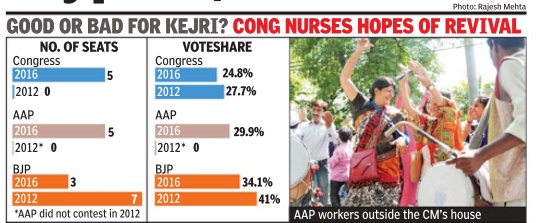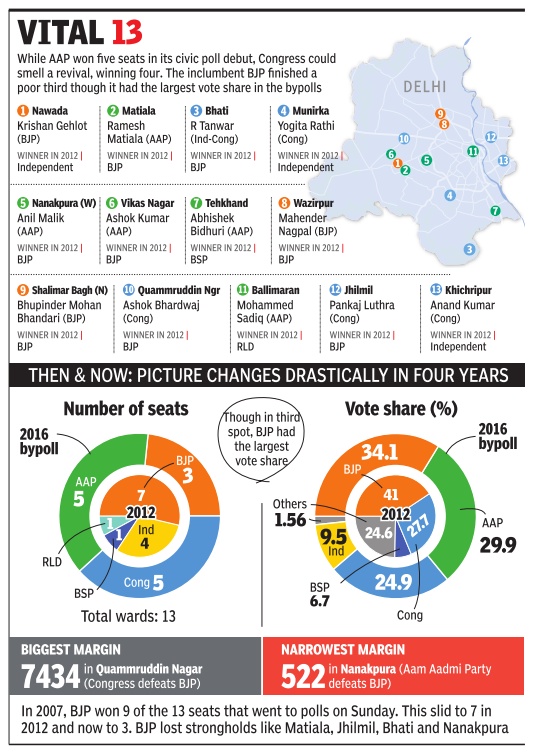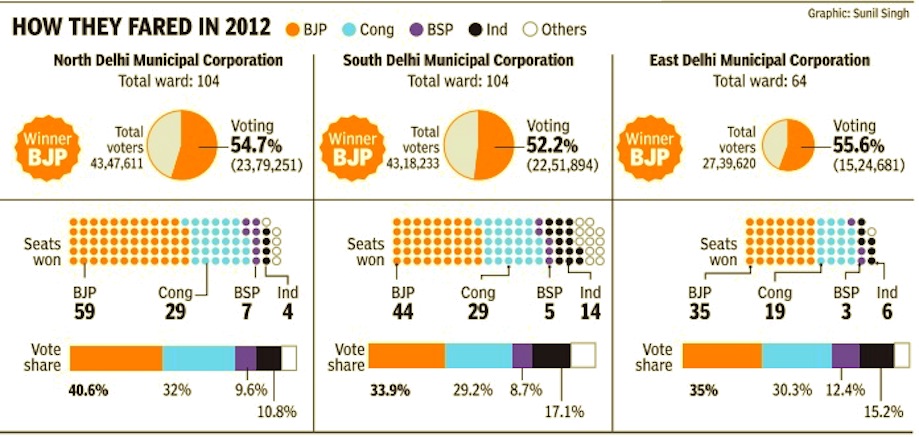Delhi: Local bodies’ elections


This is a collection of articles archived for the excellence of their content. |
Contents |
2012
See graphic

2017
Seats reserved for SCs, women/ 2017
Mayank Manohar, Poll panel notifies reserved seats, Feb 9, 2017: The Times of India

Of 272 Seats Across 3 Corpns, 46 Marked For SC & 114 For Women Candidates
Setting the tone for municipal polls in April, the state election commission (SEC) on notified the reservation of seats for women and schedule caste candidates across the 272 wards. This has paved the way for pre-election work to be carried out by SEC in consultation with the three corporations.
The scheduled caste seats were reserved based on the SC population in a ward. “For instance, under North Delhi Municipal Corporation 19.38% of the total population comprises scheduled castes.So, out of 104 seats 20 have been reserved for SC candidates. From the 20 reserved seats, 10 are for women SC candidates. The remaining 84 seats have been divided equally between women and general candidates,“ said a senior SEC official.
Out of the total 272 seats across the three corporations, 46 have been reserved for SC candidates -20 under north corporation, 15 under south corporation and 11 under east corporation. Of the remaining 226 seats, 114 have been reserved for women candidates.
While odd numbered se ats are reserved for women candidates, the even ones are for general candidates.“50% of the total SC seats are reserved for women. The same applied to seats in the general category ,“ said the senior official.
The municipal polls are significant this time as a ma jor third party , AAP, will be contesting for the first time.While the ruling BJP will be fighting to retain its turf, Congress is making a bid to regain lost ground.
After the delimitation work was officially notified in January , it changed the contours and population of municipal wards. Though the total number of municipal wards remains at 272, there is a major change from the current configuration of four wards per assembly constituency to three in many , and seven in one. The average population of each ward has been revised to 60,000 vo ters based on the 2011 census.
Sources in the corporations claimed that the configuration of the new wards after delimitation will impact ticket allocation. Political parties will face a major challenge in the constituencies where the number of wards has gone down from existing four to three as they will have to reorganise their entire block-wise structure.
“This may not go down well with the political parties as they will have to give multiple tickets to SCST candidates in a particular constituency . In some, the number of seats for SCST candidates may remain just one,“ sources said.
The SEC will now have to complete reassigning of polling booths along with demarcation of new boundaries in consultation with the three corporations.
“By next week, we will assign returning officers (RO) for mapping of polling booths. Post delimitation, many polling booths have shifted to a new ward. The work of reassigning polling booths will take nearly four weeks. Simultaneously , ROs will also inform the residents about the newlyassigned polling stations of their wards,“ added the senior official.
The impact of the 2017 reservation on incumbents
AlokKNMishra, Big guns lose wards, unsure of shifting base, Feb 9, 2017: The Times of India
Many big guns turned big losers with the notification of the list of reserved wards on Wednesday .While many of the BJP and Congress stalwarts will be barred from contesting from their strongholds, all seven seats belonging to AAP are out of the reservation list.
Former Delhi BJP chief Satish Upadhyay , councillor of Malviya Nagar, and Safdarjang Enclave's Shailendra Singh Monty will not be able to seek re-election from their current wards as both have been reserved for women. A popular BJP face in the south corporation, Monty claimed he had worked hard to make his ward a better place. Former north corporation mayor Ravindra Gupta's seat, Karol Bagh, and Yogendra Chandolia's Dev Nagar have also met with a similar fate. The former leader of house in the east corporation, B B Tyagi, also can't contest from Kishan Kunj.
The councillors affected by reservation are struggling to figure out their next move. “I am in no mood to contest from another seat, but nobody can defeat BJP here,“ Monty told TOI.
The disappointment extended to the Congress camp as well. Nizamuddin, the ward of Farhad Suri, leader of opposition at the south corporation, has been reserved for women. Suri, also a former mayor, said he might contest from another ward.In the north corporation, wards such as Rani Bagh and Kishan Ganj have been affected, said leader of opposition Mukesh Kumar Goel.
Though hit less than BJP, Congress is also unhappy .“The election commission did not accommodate our suggestions for reservation,“ said Goel. However, Delhi Congress chief Ajay Maken said, “We accept the list and have requested party leaders to find suitable candidates.“ BJP's Ashish Sood said the reservation had comprehensively covered scheduled castes.
Seat change is often not easy for big guns with most banking on personality-based polling in their wards.“Base change creates a lot of bad blood because every seat has strong ticket seekers,“ said a BJP functionary . Powerful male councillors often field women family members to beat the reservation list.
Sources said some of the big leaders might contest from newly created wards in the neighbourhood. While Congress is confi dent about winning the civic polls after 10 years, the ruling BJP hopes to counter the anti-incumbency factor. BJP MLA Vijender Gupta, who was overseeing the delimitation exercise for the party , said it would gain from delimitation as Outer Delhi, where BJP had fared well during the 2013 assembly polls, had seen a sizeable increase in the number of wards.
AAP, which considers the civic polls crucial, is likely to focus on youths. Promising not to field any `dummy' candidate in the women seats, a party member said, “Seats for women were reserved to aid in their empowerment.“
2017: Congress wins NDMC’s Sadar Paharganj zone
AlokKNMishra, Cong wins zonal elections, AAP says BJP helped, September 8, 2017: The Times of India
Not having enough numbers didn't stop two Congress candidates from being elected to crucial posts in North Delhi Municipal Corporation's Sadar Paharganj zone.
Congress councillors Usha Sharma and Prerna Singh were elected as deputy chairman and standing committee member, respectively, with nine votes each.A third candidate of the party, Alley Mohammad, lost to an AAP corporator as, sources said, a consensus couldn't be reached.
The zone has 13 wards and 17 members--eight belonging to AAP (including four aldermen), six to Congress and three to BJP . All three parties fielded candidates for three posts.
For the post of chairperson of zonal committee, Babita from AAP , Alley Mohammad Iqbal from Congress and Avtar Singh from BJP were in fray . Of 17 votes polled, eight went to Babita, six to Iqbal and three to Singh. Since nobody touched the winning mark of nine votes, another poll had to be conducted after removing the candidate with the least number of votes.
In the second poll, Babita again got eight votes and Iqbal six as BJP councillors abstained from voting. AAP alleged that BJP councillors abstained from voting as the Congress candidate was a Muslim.
In the elections to the post of deputy chairman and standing committee member, BJP's Ravinder Kumar withdrew his nominations from both posts. For the first one, the contest was between Usha Sharma of Congress and Mohammad Sadiq of AAP . Congress had only six votes but Sharma got nine votes, thereby trumping Sadiq.
For the post of standing committee member, Congress's Prerna Singh contested against AAP's Rakesh Kumar, who is also the leader of the opposition in the House. Singh, too, got nine votes.
AAP claimed BJP members had voted for Congress as in both elections its own candidates received eight votes. “Congress's candida te would have won the election for the seat of chairperson also, but he didn't get BJP votes for being a Muslim. BJP is hand in glove with Congress in the corporation,“ AAP's Kumar said, adding that there was no cross-voting from AAP .
Kumar also claimed that the “union of BJP and Congress“ would weaken the opposition in the corporation and important issues would be delayed or not taken up altogether. “It will also lead to corruption,“ he said.
Congress rubbished claims of an accord with BJP .“If we did, we would have won the election for the post of chairperson too,“ said Mukesh Goel of Congress.
Goel said there was secret voting so it wasn't possible to know who voted for whom.“May be AAP councillors also voted for us,“ he said.
A BJP member, however, said the party didn't want an AAP member in the standing committee.
Voter turnout
2007, 2017: low in upscale South Delhi

Low Turnout May Be Sign Of Disillusionment With Parties
It is a paradox: the affluent residential colonies that are more robustly covered by the RWA system are often the least interested in casting votes for the municipal corporations. Perhaps it has to do with the fact that residents of these colonies have the wherewithal to deal with civic problems even if the corporations ignore their complaints. In 2012, the burgeoning RWA movement had created a lot of interest in the civic bodies, and yet the turnout in these areas had been just around 45%. With the unusually hot weather and a general disillusionment with political parties, it would be interesting to watch the turnout in these areas.
The voting percentage in the byelection for the Rajouri Garden assembly seat was 47%. That, however, can be attributed to a general trend in byelections. Wing Commander JS Chaddha (retd), who heads the RWA in East of Kailash and is the convenor of URJA (United Residents Joint Action), however, has doubts if the voters from the affluent colonies will turn up at the polling booths on Sunday .“The problem is not about awareness but about the high level of frustration with the system,“ he said. Chetan Sharma, chair man of the Federation of GK2 RWAs, pointed out that in 2012 when the RWA movement was at a peak, the urban colonies had voted in greater numbers than earlier. Despite this, the turnout was less than 50%. “The RWA movement has since got watered down, so it will definitely have an effect on this year's turnout,“ he said. He also attributed the lack of voter interest to the reluctance of the state election commission to involve the RWAs and citizen groups in election-related activities this time. The delimitation exerci se, by geographically balancing the urban-rural presence in the wards, has further diluted the political relevance of votes from upscale colonies. Meena Gangahar, member of the Greater Kailash RWA, argued that the politicians considered jhuggi-jhopdi dwellers and urban villages as their vote banks. “Our ward now has many JJ colonies and villages included in it. Their population provides the politicians with a reliable vote bank,“ she said. “Why should we vote for leaders who will have nothing to do with our concerns?“ Indeed, in 2012, the east Delhi region largely made up of unauthorised or regularised colonies and urban villages recorded the highest turnout. South Delhi, home to high-profile addresses, recorded the least. Perhaps the apathy also has to do with residents of affluent areas having access to power centres as well as the financial muscle to solve their problems with or without the intervention of their municipal councillor.
“People in the richer areas live in gated apartments where they have power backup and private workers ensuring sanitary conditions.This parallel civic system is available to them,“ explained BS Vohra, president of the East Delhi RWA Joint Front, who reiterated that turnout in the posher areas would be less than earlier this year.
Responding to the RWAs' criticisms, Delhi State Election Commissioner SK Srivastava said that the commission “had written to the RWAs that if they wished to, they could participate in helping the election commission staff in organising the polling“. The commission had even nominated staff to help RWAs disseminate information about the polling booths and election-related questions, he added.